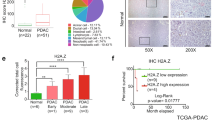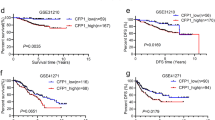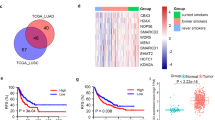Abstract
Lung cancer is the leading cause of cancer deaths. Despite optimal diagnosis and early treatment, many patients die of recurrent disease. There are no sufficiently useful biomarkers to predict the risk of tumor recurrence. Here, we show that expression of histone macroH2A1.1 and macroH2A2 predicts lung cancer recurrence, identifying these histone variants as a novel tool for an improved risk stratification of cancer patients. Moreover, macroH2A isoforms are highly expressed in cells undergoing senescence, a known antitumor mechanism, suggesting macroH2A1.1 may be a useful biomarker for senescent cells in tumors.
This is a preview of subscription content, access via your institution
Access options
Subscribe to this journal
Receive 50 print issues and online access
$259.00 per year
only $5.18 per issue
Buy this article
- Purchase on Springer Link
- Instant access to full article PDF
Prices may be subject to local taxes which are calculated during checkout



Similar content being viewed by others
References
Braig M, Lee S, Loddenkemper C, Rudolph C, Peters AH, Schlegelberger B et al. (2005). Oncogene-induced senescence as an initial barrier in lymphoma development. Nature 436: 660–665.
Chen Z, Trotman LC, Shaffer D, Lin HK, Dotan ZA, Niki M et al. (2005). Crucial role of p53-dependent cellular senescence in suppression of Pten-deficient tumorigenesis. Nature 436: 725–730.
Collado M, Gil J, Efeyan A, Guerra C, Schuhmacher AJ, Barradas M et al. (2005). Tumour biology: senescence in premalignant tumours. Nature 436: 642.
Collado M, Serrano M . (2006). The power and the promise of oncogene-induced senescence markers. Nat Rev Cancer 6: 472–476.
D'Amico TA . (2008). Molecular biologic staging of lung cancer. Ann Thorac Surg 85: S737–S742.
Guerra C, Mijimolle N, Dhawahir A, Dubus P, Barradas M, Serrano M et al. (2003). Tumor induction by an endogenous K-ras oncogene is highly dependent on cellular context. Cancer Cell 4: 111–120.
Hayflick L . (1965). The limited in vitro lifetime of human diploid cell strains. Exp Cell Res 37: 614–636.
Hothorn T, Hornik K, van de Wiel MA, Zeileis A . (2006). A lego system for conditional inference. Am Stat 60: 257–263.
Jackson EL, Olive KP, Tuveson DA, Bronson R, Crowley D, Brown M et al. (2005). The differential effects of mutant p53 alleles on advanced murine lung cancer. Cancer Res 65: 10280–10288.
Jemal A, Siegel R, Ward E, Murray T, Xu J, Thun MJ . (2007). Cancer statistics, 2007. CA Cancer J Clin 57: 43–66.
Kustatscher G, Hothorn M, Pugieux C, Scheffzek K, Ladurner AG . (2005). Splicing regulates NAD metabolite binding to histone macroH2A. Nat Struct Mol Biol 12: 624–625.
Michaloglou C, Vredeveld LC, Soengas MS, Denoyelle C, Kuilman T, van der Horst CM et al. (2005). BRAFE600-associated senescence-like cell cycle arrest of human naevi. Nature 436: 720–724.
Narita M, Nunez S, Heard E, Narita M, Lin AW, Hearn SA et al. (2003). Rb-mediated heterochromatin formation and silencing of E2F target genes during cellular senescence. Cell 113: 703–716.
Pehrson JR, Costanzi C, Dharia C . (1997). Developmental and tissue expression patterns of histone macroH2A1 subtypes. J Cell Biochem 65: 107–113.
Pehrson JR, Fried VA . (1992). MacroH2A, a core histone containing a large nonhistone region. Science 257: 1398–1400.
Serrano M, Lin AW, McCurrach ME, Beach D, Lowe SW . (1997). Oncogenic ras provokes premature cell senescence associated with accumulation of p53 and p16INK4a. Cell 88: 593–602.
Zhang R, Poustovoitov MV, Ye X, Santos HA, Chen W, Daganzo SM et al. (2005). Formation of MacroH2A-containing senescence-associated heterochromatin foci and senescence driven by ASF1a and HIRA. Dev Cell 8: 19–30.
Zhu CQ, Shih W, Ling CH, Tsao MS . (2006). Immunohistochemical markers of prognosis in non-small cell lung cancer: a review and proposal for a multiphase approach to marker evaluation. J Clin Pathol 59: 790–800.
Acknowledgements
We thank Dr Esther Herpel for lung cancer tissue microarrays. AGL is supported by the EMBL, the NoE The Epigenome and the Marie Curie RTN Chromatin Plasticity.
Author information
Authors and Affiliations
Corresponding author
Additional information
Supplementary Information accompanies the paper on the Oncogene website (http://www.nature.com/onc)
Rights and permissions
About this article
Cite this article
Sporn, J., Kustatscher, G., Hothorn, T. et al. Histone macroH2A isoforms predict the risk of lung cancer recurrence. Oncogene 28, 3423–3428 (2009). https://doi.org/10.1038/onc.2009.26
Received:
Revised:
Accepted:
Published:
Issue Date:
DOI: https://doi.org/10.1038/onc.2009.26
Keywords
This article is cited by
-
MacroH2A1.1 as a crossroad between epigenetics, inflammation and metabolism of mesenchymal stromal cells in myelodysplastic syndromes
Cell Death & Disease (2023)
-
Cellular senescence in cancer: clinical detection and prognostic implications
Journal of Experimental & Clinical Cancer Research (2022)
-
The diagnostic and prognostic value of H2AFY in hepatocellular carcinoma
BMC Cancer (2021)
-
Evolution of a histone variant involved in compartmental regulation of NAD metabolism
Nature Structural & Molecular Biology (2021)
-
HISTome2: a database of histone proteins, modifiers for multiple organisms and epidrugs
Epigenetics & Chromatin (2020)



